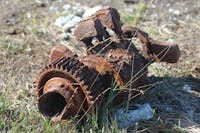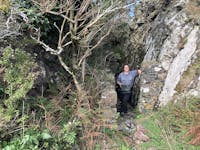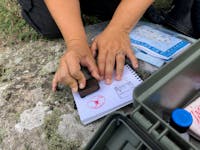Letterboxing on Lundy
18th September 2018
Last week Natalie and I spent a delightful two days with our friends Hannah and Adam on the beautiful island of Lundy in the Bristol Channel, 12 miles off the coast of North Devon.
I’ve been wanting to visit Lundy for years. The island is managed by the Landmark Trust, a UK charity who look after historic buildings and make them available as holiday rentals.
Our first experience with the Landmark Trust was the original /dev/fort back in 2008 when we rented a Napoleonic Sea Fortress on Alderney in the Channel Islands. Ever since then I’ve been keeping an eye out for opportunities to try out more of their properties: just two weeks ago we stayed in Wortham Manor and used it as a staging ground to help prepare a family wedding.





I cannot recommend the Landmark Trust experience strongly enough: each property is unique and fascinating, they are kept in great condition and if you split the cost of a larger rental among a group of friends the price can be comparable to a youth hostel.
Lundy is their Crown Jewels: they’ve been looking after the island since the 1960s and now offer 23 self-catering properties there.
We took the ferry out on Tuesday morning (a truly horrific two hour voyage) and back again on Thursday evening (thankfully much calmer). Once on Lundy we stayed in Castle Keep South, a two bedroom house in the keep of a castle built in the 13th century by Henry III, after he retook the island from the apparently traitorous William de Marisco (who was then hanged, drawed and quartered for good measure—apparently one of the first ever uses of that punishment). Lundy has some very interesting history attached to it.





The island itself is utterly spectacular. Three miles long, half a mile wide, surrounded by craggy cliffs and mostly topped with ferns and bracken. Not a lot of trees except for the more sheltered eastern side. A charming population of sheep, goats, Lundy Ponies and some highland cattle with extremely intimidating horns.








(“They’re complete softies. We call that one Boris because he looks like Boris Johnson”—a lady who works in the Tavern)
Lundy has three light houses (two operational, one retired), the aforementioned castle, a charming little village, a church and numerous fascinating ruins and isolated buildings, many of which you can stay in. It has the remains of two crashed WWII German Heinkel He 111 bombers (which we eventually tracked down).





It also hosts what is quite possibly the world’s best Letterboxing trail.
Letterboxing?
Letterboxing is an outdoor activity that is primarily pursued in the UK. It consists of weatherproof boxes hidden in remote locations, usually under a pile of rocks, containing a notebook and a custom stamp. The location of the boxes is provided by a set of clues. Given the clues, your challenge is to find all of the boxes and collect their stamps in your notebook.
On Lundy the clues can be purchased from the village shop.
I had dabbled with Letterboxing a tiny bit in the past but it hadn’t really clicked with me until Natalie (a keen letterboxer) encouraged us to give it a go on Lundy.
It ended up occupying almost every waking moment of our time there, and taking us to every far-flung corner of the island.
There are 28 letterboxes on Lundy. We managed to get 27 of them—and we would have got them all, if the last one hadn’t been located on a beach that was shut off from the public due to grey seals using it to raise their newly born pups! The pups were cute enough that we forgave them.



To give you an idea for how it works, here’s the clue for letterbox 27, “The Ugly”:

There were letterboxes in lighthouses, letterboxes in ruins, letterboxes perilously close to cliff-faces, letterboxes in church pews, letterboxes in quarries, letterboxes in caves. If you thought that letterboxing was for kids, after scrabbling down more perilous cliff paths than I can count I can assure you it isn’t!







On Thursday I clocked up 24,000 steps walking 11 miles and burned 1,643 calories. For comparison, when I ran the half marathon last year I only burned 1,222. These GPS tracks from my Apple Watch give a good impression of how far we ended up walking on our second day of searching.



When we checked the letterboxing log book in the Tavern on Wednesday evening we found most people who attempt to hit all 28 letterboxes spread it out over a much more sensible timeframe. I’m not sure that I would recommend trying to fit it in to just two days, but it’s hard to imagine a better way of adding extra purpose to an exploration of the island.
Should you attempt letterboxing on Lundy (and if you can get out there you really should consider it), a few tips:
- If in doubt, look for the paths. Most of the harder to find letterboxes were at least located near an obvious worn path.
- “Earthquake” is a nightmare. The clue really didn’t help us—we ended up performing a vigorous search of most of the area next to (not inside) the earthquake fault.
- The iPhone compass app is really useful for finding bearings. We didn’t use a regular compass at all.
- If you get stuck, check for extra clues in the letterboxing log book in the tavern. This helped us crack Earthquake.
- There’s more than one pond. The quarry pond is very obvious once you find it.
- Take as many different maps as you can find—many of the clues reference named landmarks that may not appear on the letterboxing clue map. We forgot to grab an offline copy of Lundy in the Google Maps app and regretted it.
If you find yourself in Ilfracombe on the way to or from Lundy, the Ilfracombe Museum is well worth your time. It’s a classic example in the genre of “eccentric collects a wide variety of things, builds a museum for them”. Highlights include a cupboard full of pickled bats and a drawer full of 100-year-old wedding cake samples.
More recent articles
- Gemini 2.0 Flash: An outstanding multi-modal LLM with a sci-fi streaming mode - 11th December 2024
- ChatGPT Canvas can make API requests now, but it's complicated - 10th December 2024
- I can now run a GPT-4 class model on my laptop - 9th December 2024